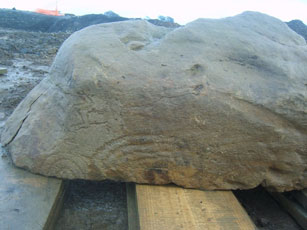|
|
| wells at Tara |
![]()
|
The approach to the well
There are in fact six wells at Tara
(or seven depending on what map you
use as some may have been filled in
or dried up) and not all of them are
religious wells in the traditional
sense (or at least as far as we
know), but some do bear the name of
Saint Patrick. The Well of the White
Cow is situated at the base of Tara
Hill and just to confuse matters it
has multiple names: Caprach Cormac;
meaning ‘Cormac’s well’, a nod to
one of the King’s at Tara, Liagh;
meaning ‘the Physician’s well’,
possibly a reference to the belief
in its healing property, Tipra bo
finne; meaning ‘the well of the
White Cow’, Deare dubhe; meaning
‘the well of the dark eye’ -
possibly a description of it’s
appearance or relating to its power
to heal the eyesight, and Poll
tocair na tuiliche; meaning ‘Trial
by Ordeal’. There is a medieval
manuscript that talks about entering
the waters and coming up again: if
you had a black spot you were guilty
and if you were spotless you were
innocent.
It is also known as Saint Patrick’s
well. Some of these names can be
explained with their connection to
myth (Poll tochair na tuiliche), a
possible local and more ‘modern’
fond invention (Caprach Cormac) or
simply names expressing its use or
purpose (Liagh and Deare Dubh), but
the name of Tipra bo finne is by far
the most intriguing name (although
it to may be a more modern
association). This name appears in a
mid medieval set of legends – from
which almost all of the legends of
Tara come. You will read and you
will also be told that these legends
are very early and speak of
Ireland’s pagan past, but it isn’t
necessarily so. The myths are
medieval in date in terms of when
they were collated by Christian
monks, and they have been overlaid
with obscure imagery often to convey
Christian ideas – and the white cow
is one such idea. The main citations
for the myths of a pagan,
life-giving cow are the Ulster Cycle
which contains the famous Tain Bo
Cuailnge (Two sources; both twelfth
century), the Historical Cycle
containing the famous vision of Conn
of the Hundred Battles (again a
twelfth century work of poetry and
prose) and the Fenian or Ossianic
Cycle which contains the famous
story of the well surrounded by
trees and the salmon of wisdom (a
thirteenth century work) and the
Mythological cycle (a twelfth
century work).
|
| from HERE |
![]()
![]()
The healing well between Rath Lugh and the church at Skreen/Skryne
|
||||||||
![]()
![]()
![]()
![]()
![]()
![]()
![]()
![]()

![]()
Tara Tara Tara
Please contact for any questions: anitagreg@gmail.com
|
Colm Toibin |
|
|
|
|

![]()
![]()
![]()









